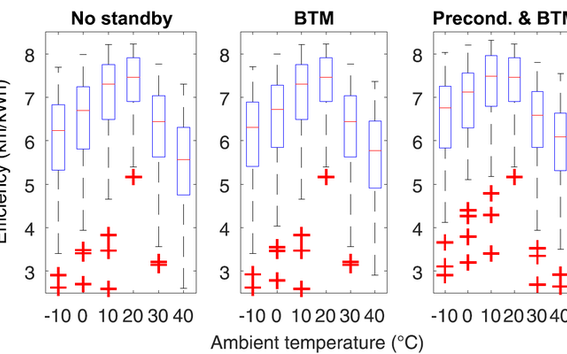Electric vehicles in the cold

Transportation sector consumes over 25% of all energy and more than 60% of oil. Cars make a major contribution to the global CO2 emissions. Electric mobility is a promising future sustainable transportation solution. The sensitivity of the battery performance to temperature is often overlooked in the related Electric Vehicle (EV) studies.
Researchers at the New Energy Technologies group at Aalto University have developed an improved lithium-ion battery model to better understand the temperature effects. The new battery model has been combined with a vehicle fleet model to analyze the related effects in large scale.
City of Helsinki with its local driving patterns was used as a test case. The simulated test fleet comprised 212 EVs with a 120 km nameplate range.
We found that in terms of e-mileage, the EV-range was maximized near +20°C as the vehicle's battery is subject to less secondary load from heating, ventilation, air conditioning, and active battery thermal management. The efficiency at temperature extremes (-10°C and +40°C) could be improved by 8-9% by pre-heating the cabin at low ambient temperature and pre-cooling it at high outdoor temperature ca 10 minutes before departure.
Low ambient temperature tends to decrease the battery charging speed due to higher internal resistance. The median of the EV fleet's self-weighted mean charging power decreased by 15% at -10°C outdoor temperature compared to reference outdoor temperature of +20°C. Battery heating during parking was found to significantly improve charging speed at low temperatures, even up to 30%. The findings are important to maximize the efficiency of an EV fleet and for time-constrained charging if vehicles need to queue for charging service.
Lindgren, J., Asghar, I., Lund, P. D., A hybrid lithium-ion battery model for system-level analyses. International Journal of Energy Research 2016, 40, 1576-1592
Lindgren, J., Lund, P. D., Effect of extreme temperatures on battery charging and performance of electric vehicles. Journal of Power Sources 2016, 328, 37-45.
- Published:
- Updated:
Read more news

This is how smart textiles can look like: self-cleaning cotton or a colour-changing print
An article by YLE Svenska about 'Beyond e-Textiles' project and 'Interlaced' exhibition at the University of Turku
A new project in Espoo aims to improve disparities in children's learning outcomes – with the goal of preventing social segregation
Supporting children's learning skills has a major impact on their further education and employment, among other things.
Can the impact of performing arts be measured? Researchers record applause and CO2 levels in Kapsäkki's UKK musical
The UKK musical, produced by Music Theatre Kapsäkki and Greta Production, is a vibrant cabaret about Finland’s political history during the era of President Kekkonen. Its impact is now being studied scientifically. The research, conducted in collaboration with Aalto University's MAGICS infrastructure, Greta Production, and Kapsäkki, measures audience and performer experiences through innovative methods, including various sensors and surveys.